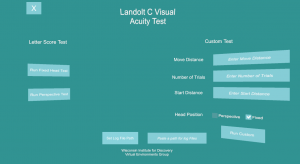Description:
The final outcome of this semester is the Landolt C Visual Acuity VR application, or Landolt VR. This application allows a user to run the Landolt C visual acuity test in three configurations across all devices compatible with Unity’s mixed VR plugin. The goal of which is to better measure both individual visual acuity in a single device, and visual quality output by different devices.
The three configurations are a fixed head perspective standard 70 trial test, a free head perspective standard 70 trial test, and a custom test that can be run in either head position. The custom test allows the user to change the start distance of the C object, the number of trials before the test completes, and the linear movement distance.
The procedure is best explained in the context of the 70 trial standard test. When this option is selected, the subject will be asked to decide the direction the C object faces 5 times per 14 different distances, with the C distance increasing each time. Between each guess, there is a brief rest period where a blank screen is displayed. Upon completion of the test, a Snellen Letter score will be displayed on the screen, and the user can exit the test to the main screen. Also upon completion a log file is created that contains all information pertinent to the test, and includes a record of each individual trial.
Creating this project took several weeks of research prior to the start of coding. In those weeks I learned the founding principles of visual acuity testing, the standard optometry procedures for issuing a visual acuity test, analysis of visual acuity testing results, and finally, how to construct and validate new visual acuity tests using standard symbols. I also had to learn some basic physiology of the eye to familiarize myself with vocabulary ahead of conducting other research.
Project Feelings:
I’m quite happy with the results of this semester. Having been a relative novice in terms of developing VR applications, it was satisfying alone to create a fully functioning project on my own. On top of that, I was challenged to learn material outside of my field, and bring results from research into a new medium. While there was plenty of content regarding visual acuity testing, and the basics of optometry practice, there was little to nothing about administering such a test on screen, let alone in VR. While I initially found that frustrating, it became something I found enjoyment in, working on something that perhaps no one has done before.
This is only my second time developing a VR application, and the first time it’s been non-game related. I found that I was able to create something functional, and relatively easy / aesthetically pleasing to use. Unity is a complicated but rewarding tool to learn, after this semester I feel much more confident in my development skills using it. The final product, combined with the improvement of my research and Unity skills was, and is satisfying.
Project Challenges:
The biggest hurdle was the lack of information out there with any relation to what I was attempting to build. I had a good idea of what I was trying to accomplish fairly quickly, but without anything to reference I was pushed outside the comfort zone of feeling what I was doing was correct. I still wanted to produce something accurate, that performed as close to a standard as I could get. It took some realizing that things like these are never done perfectly the first time, and validation comes from experimentation in the case of doing something new.
The next considerable challenge was threading. It took a good few weeks to figure out how to time things for the periods of rest and the periods of trial. While the co-routine / invoke functions unity provides work perfectly fine, my lack of Unity knowledge pushed me towards my C# comfort zone. As someone who uses C# for .NET web development, I foolishly thought Unity would play nice with C# timers, and even went so far as trying to write my own multi threading setup using them. Guidance ultimately put me back on the right track. Asking for help is never bad.
More time:
Given more time I would have loved to see this through testing. I feel like this is something useful, and would have preferred to run more trials on people that I don’t know so well. Not only to verify the process, but to improve the design of the application.
The next thing I would’ve liked to focus on is design. While it’s pleasant enough to look at, I would’ve liked more time to learn more about certain alignment techniques for Unity UI’s. I think that would be a small improvement that could make this product better.
It would’ve also been nice to run this past an Optometrist. While I was confident enough in my own research regarding the basic principles, I’m sure there are inaccuracies in my procedure that someone with more experience could help iron out.

